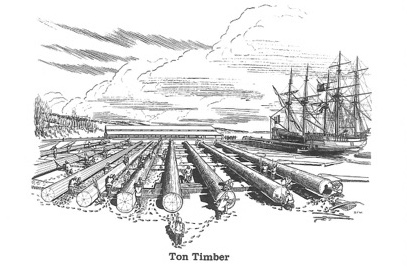
The Most difficult aspect of the Masting trade was getting the ten ton logs to the nearest large river thru what was often ten miles of hilly wilderness. Hills killed so many oxen, spares were stationed all along the route. The crushed animals were just cut out of the harness and quickly replaced and the log never stopped. Logs were moved during the winter and great preparation of ice tracks were an important preparation. What moves Duck Pond to the front of the line with just a cursory examination of the location can be seen today driving on Route 302 from the power line (below Hawkes Plaza) to the Dunkin Donut shop (and look left down the power line). You travel a short, remarkably flat, gentle downward slope all the way to the River. Duck Pond Masts would almost deliver themselves to the Presumpscott with a push. It would be a quicker trip requiring far fewer Oxen, Men, and Supplies transported across the Atlantic, and very few replacement Oxen too. A quick look at a topographical map explains the setup for the very biggest, hardest to find Pines and the routes to the river. When sheltered by hills and watered by a lake, White Pines live long enough to get big enough to power those huge three decker ships of the line !
"Ship of the Line" masts were the nuclear bombs of their day. They decided National Power Balances. Great Pines suitable as masts for ships of the line were far and few between*, let alone easily accessible ones. Masting began in Maine in 1634. and became New England’s first major industry by 1640 just 20 years after Plymouth Rock. By 1700, the easiest masts on the Piscataqua were 20 miles from the river. Surveys for Masts would have spotted this site well before 1650 (Just look for the tallest trees). It was a bit beyond Wildcatters grabbing a few masts as cargo for the return voyage to England. They had been spotting and grabbing the easiest for 20 years. But it would have been a perfect target for Prides organized crew in a planned raid from England in a military emergency. So when the fate of the British Empire hung in the balance on the supply of ship masts in Naval Mast crisis of 1652, it would have been THE most logical place for Lord Prides highly skilled, and experienced naval lumberjacks, fresh out of the now denuded Nonesuch Forest to go.
Next door to the Presumpscott, the Nonesuch river in Scarborough, an area historically noted as mast rich, is named for Nunsuch Forest. Nunsuch was Lord Pride's Family home during the 1650's when these rivers were being Masted. His veterans learned to Mast in Nunsuch Forest, south of London in the years after the Civil War. They named one of the richest and easiest masting sites in America for the quiet english forest where they recovered from the War, finally got paid, and grew into skilled Lumberjacks, where they traded the screams and horrors of medieval war for the sounds of chirping birds.
In the early 1650's when Mast road would have gotten its start from whomever, there were 13 Familys in Portland, and 7 at Presumpscott Falls. This very clearly indicates that Mast Road was one of the first roads ever created in Maine, and definitely the first in Cumberland County.
Lord Prides Work Orders were reported to still exist as of 1926 in Navy Board Records by the Cambridge University Masterpiece Forests and Seapower (including Duck pond ?) Mass digitization of Navy records has not been announced yet, but is expected. However, Robert Albion thought they were "threatened" due to storage issues in 1926, and the Luftwaffe may have done them in WW2.
*Forests and Seapower - Robert Albion P 241
Tall Trees Tough Men - Robert Pike P 49
Maritime History of Maine - William Hutchinson. ROWE P 34
New England masts and the King's Broad Arrow - Samuel F Manning P 28

The Presumscott (translates "many falls") may be unique in that its original lower falls was a low gentle one which emptied into tidal waters.
This provided advantages to the transportation loading process unavailable elsewhere. Duck Pond masts
might have been loaded more easily than at the finest ports of the day, literally floating the logs into the rear bay of the Mast Ship backed up to the falls.
This tidal area at Presumpscott Falls was used to protect an entire shipment of masts stolen from the British during the American Revolution and as a result they bombed Portland.
I was told as a child they (but have been unable to confirm the use of the actual falls) they took a ship of loaded masts from the
British and reversed the process done in 1653, loading the logs up the falls from the Ship putting the great sticks above the falls,
beyond the reach of the British, despite a Royal Navy Warship, the HMS Senegal, sent to Casco Bay to procure them.









